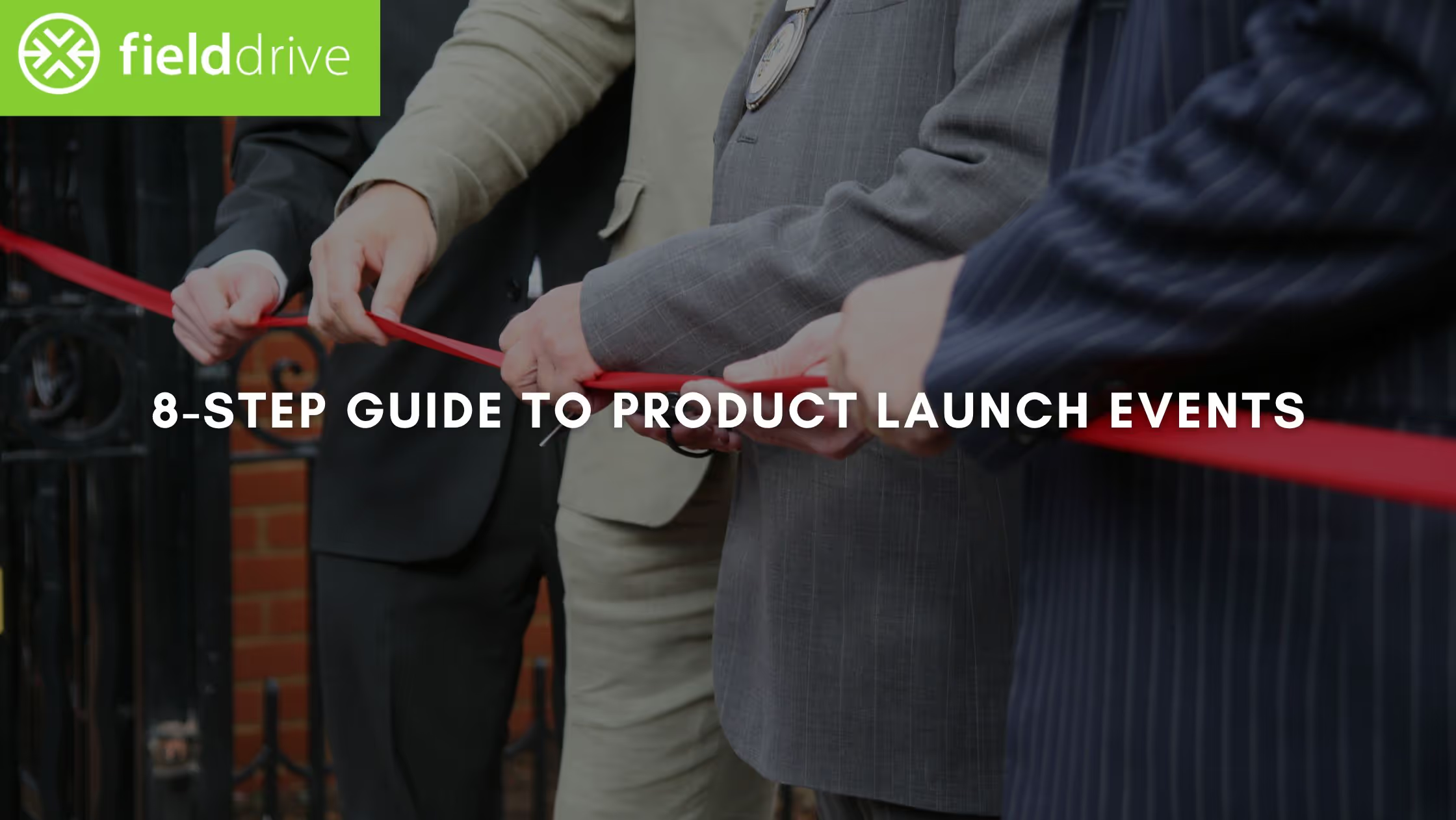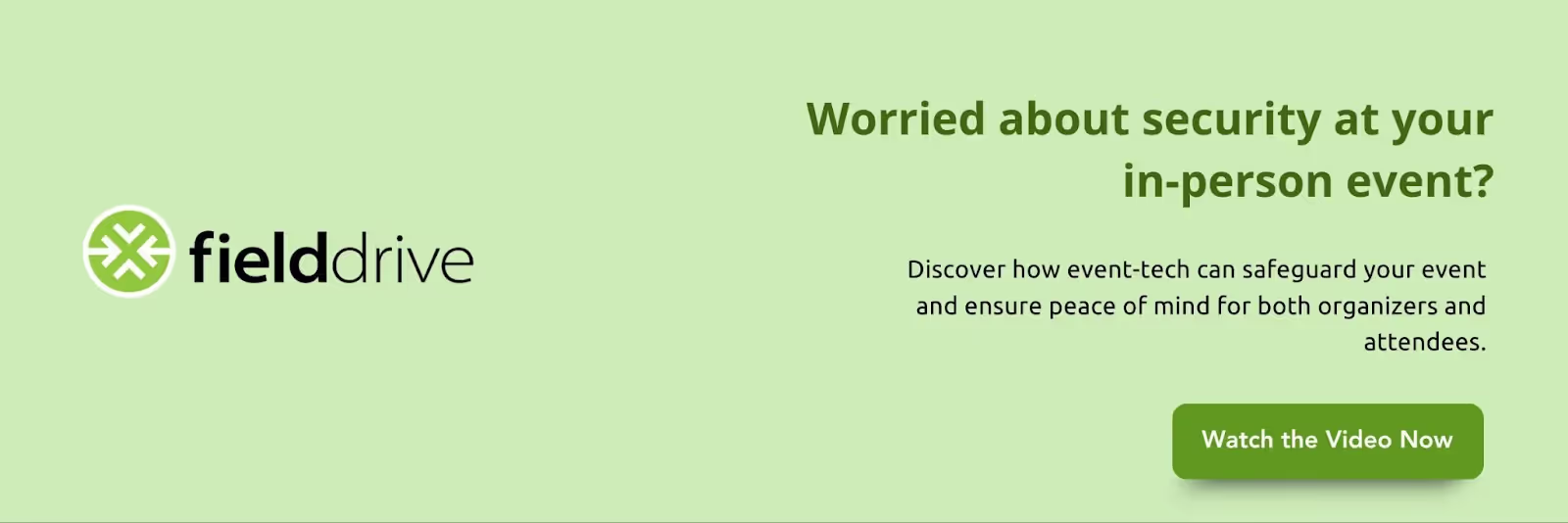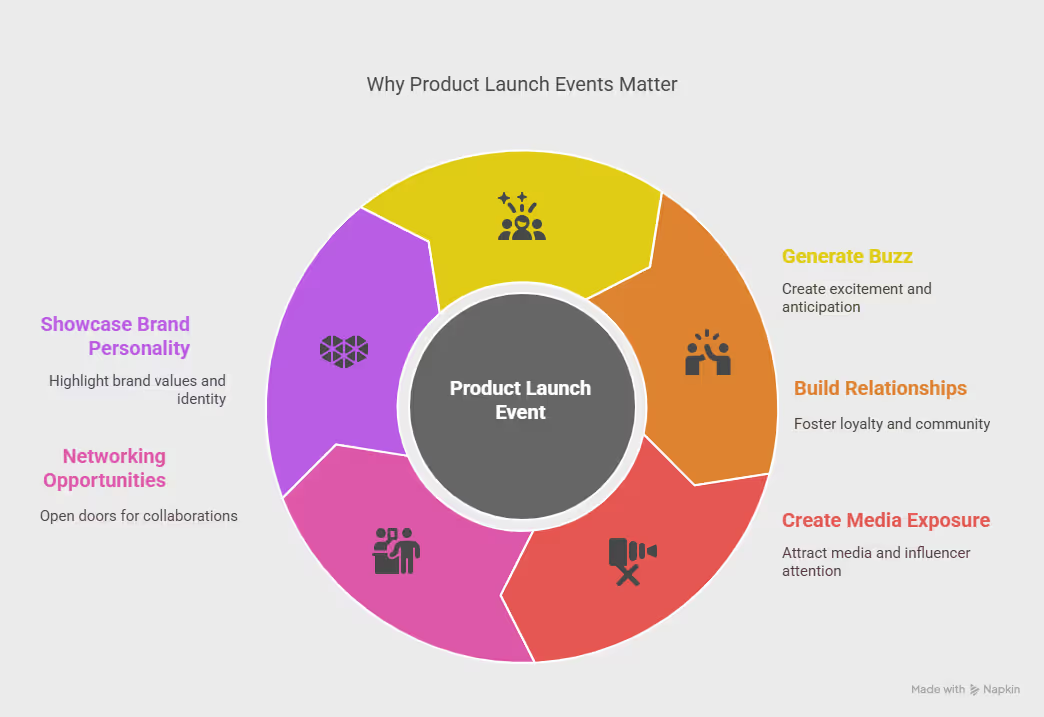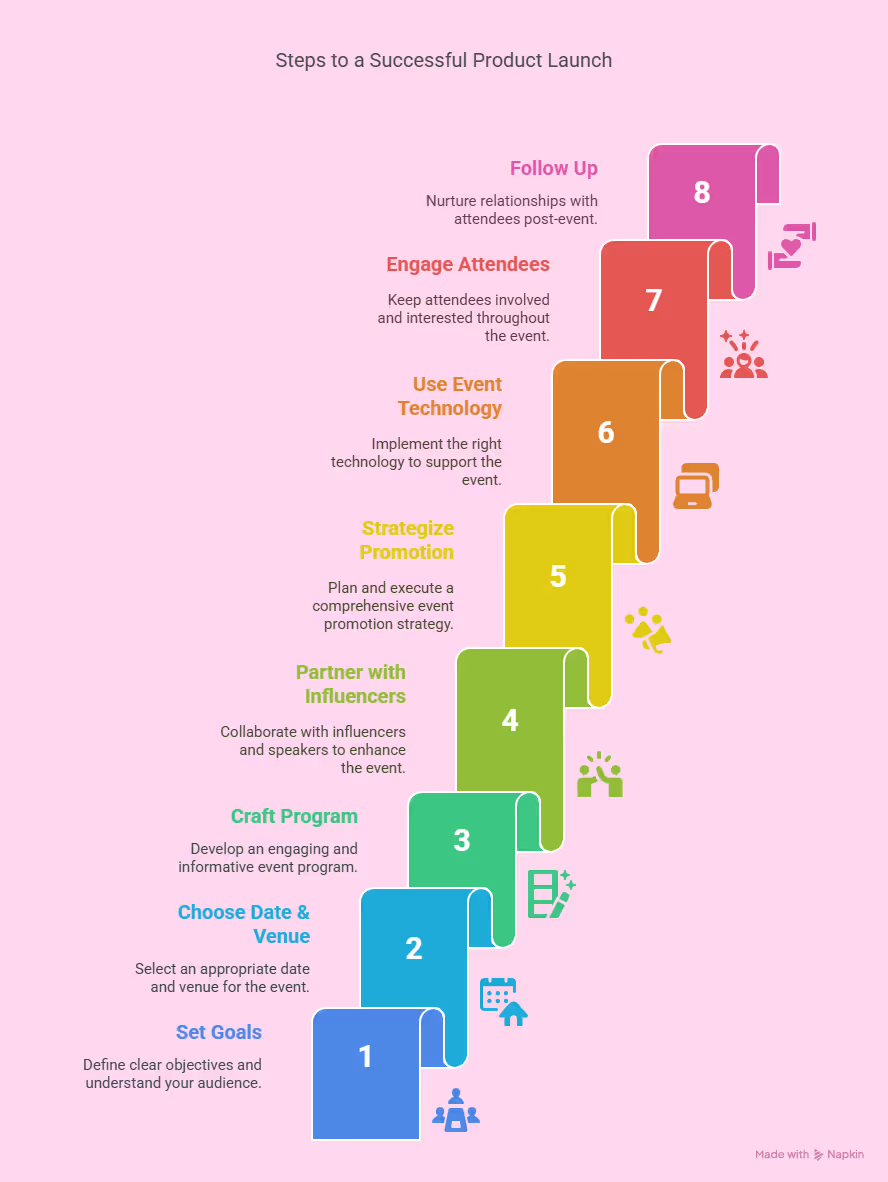8 Steps to Plan a Successful Product Launch Event: Ideas + Tips
Plan a successful product launch event with these 8 proven steps. Get expert tips and creative ideas to make your launch memorable and impactful.

CONTENT
Do you want your next product launch event to be a huge success, leaving a lasting impression on your audience? A successful product launch event can elevate your brand, create lasting buzz, and set the stage for growth.
According to recent stats, 81% of marketers say that event marketing is a key driver of business growth. The impact of a well-executed launch event is real, and it starts with effective planning.
But let's be honest, planning a product launch isn't always as smooth as we hope. There’s the pressure to engage your audience, deliver on high expectations, and make sure everything runs seamlessly. And when things don't go as planned, the stress can pile up quickly.
But with the right strategy in place, you can turn your launch event into a standout experience. In this blog, we'll walk you through the essential steps for organizing a product launch event that mesmerizes everyone. From understanding why launch events matter to creative ideas that captivate your audience, we’ll cover everything to make your next launch unforgettable.
What is a Product Launch Event?
A product launch event is more than just an announcement; it's the official debut of a new product or service to the market. It’s a carefully crafted opportunity to showcase your offering, generate excitement, and engage your target audience in a memorable way.
It is your product's first public appearance, where you introduce it to the world, investors, media, influencers, and your customers all come together to witness this exciting moment.
You can host a product launch event in various formats to suit your audience and objectives. Depending on your product and goals, you can choose from virtual, in-person, or hybrid events depending on your product and goals. Each format has its own unique advantages and ideal use cases, so let's explore them in more detail.
In-Person Product Launch Events
These events offer the chance to create personal, face-to-face interactions with your audience. They foster community, build deeper relationships, and provide an opportunity for attendees to experience your product firsthand.
- Best for: Product creators or businesses with a local or regional focus. It’s ideal for physical products that benefit from a tactile, experiential introduction. And with solutions like fielddrive, which provides facial recognition, instant badge printing, self-check-in kiosks, and analytics to transform your onsite events.
- Who Should Not Consider: It may also not be suitable for products that require minimal physical interaction.

Virtual Product Launch Events
Reach a global audience effortlessly, reducing location-based barriers. Virtual events allow real-time interactions, such as Q&A sessions and live polls, keeping your audience engaged and excited.
- Best for: Creators or businesses with an international or dispersed audience. It's perfect for digital products like online courses, software, or exclusive content.
- Who Should Not Consider: Companies or creators looking for high-touch, in-person engagement or products that require physical interaction to showcase (e.g., merchandise, physical experiences).
Hybrid Product Launch Events
Hybrid events combine the best of both worlds. They offer the flexibility of in-person interactions while extending the reach to a global audience via online streaming. This ensures that no one misses out, regardless of location.
- Best for: Brands with a local following and a strong international presence. Hybrid events work well when you want to create excitement locally and globally at the same time.
- Who Should Not Consider: If your event is entirely targeted at a local, highly interactive audience, the virtual aspect may dilute the experience. Also, hybrid events require more planning to ensure smooth integration between physical and digital experiences.
Choosing the right format for your product launch depends on your goals, audience, and the experience you want to create. But before you decide, it’s crucial to understand why these events matter in the first place. Let’s explore the key benefits of hosting a product launch event and how it can set the stage for your brand’s success.
Why Product Launch Events Matter: The Benefits
Product launch events are more than just a showcase of your new offering—they are a powerful tool to build your brand and spark long-term success. A well-planned launch can generate excitement, create lasting buzz, and set the stage for a larger marketing campaign. Here’s why these events are essential:

- Generate Buzz and Excitement: A well-executed event sparks anticipation and excitement, boosting interest and sales. Social media, live streaming, and branded hashtags amplify the buzz beyond the event.
- Build Relationships with Your Audience: Engage directly with customers and influencers, fostering loyalty and creating a community around your brand.
- Create Media Exposure: Launch events attract media and influencer attention, expanding your reach and enhancing credibility with both attendees and online followers.
- Networking Opportunities: These events bring together customers, industry professionals, and potential partners, opening doors for future collaborations.
- Showcase Your Brand’s Personality: A launch event highlights your brand’s values and identity, creating lasting emotional connections with your audience.
Organizing a thoughtful, engaging product launch event sets the stage for future growth and lasting relationships. But to reap these benefits, planning and executing the event properly is crucial. Let’s discuss how to do that.
How to Plan a Successful Product Launch Event
Planning a successful product launch event takes more than just a great product; it’s about creating an experience that resonates with your audience. Every detail, from your objectives to the event program, is crucial in building excitement and leaving a lasting impression.
Here are the essential steps to organize an impactful product launch event that drives results.

Step 1: Set Clear Goals and Understand Your Audience
Before diving into the logistics, defining your event’s objectives is crucial. This sets the tone for everything else, guiding decisions about venue, timing, and content. Identifying your target audience is just as important as knowing who you're speaking to. This ensures the event is tailored to their interests and needs. Here’s how you can do that:
- Define the Purpose of the Event: Are you looking to generate immediate sales, build brand awareness, or establish long-term customer relationships? Be specific. For example, if your goal is to create buzz, focus on building anticipation with teasers leading up to the launch.
- Identify Key Metrics for Success: Determine what success looks like. It could be the number of attendees, social media mentions, or media coverage.
- Understand Your Target Audience: Who are they? What do they care about? Whether you're targeting industry professionals or general consumers, knowing your audience helps shape your event.
- Align the Event with Brand Messaging: The tone and style of your event should reflect your brand’s values. If your brand is casual and fun, create a laid-back atmosphere with interactive experiences. If it’s a luxury brand, opt for an elegant and sophisticated vibe if it's a luxury brand.
Step 2: Choose the Right Date and Venue
Selecting the perfect venue and date is crucial to ensure maximum attendance and a memorable experience. A well-chosen venue not only enhances the atmosphere but also impacts the logistics of your event. Here’s what you can do:
- Pick the Right Date: Avoid scheduling your launch on major holidays, industry events, or during busy seasons when potential attendees might be distracted. For example, if you’re launching a new skincare line, avoid clashes with major beauty events or peak holiday seasons.
- Consider Venue Size and Layout: Make sure the venue is large enough to comfortably accommodate your expected guests. It should also have the right layout for your event’s activities, whether it’s a product demo or a networking session.
- Location, Location, Location: The venue should be easily accessible for your target audience. If you’re targeting local professionals, choose a centrally located venue. For international audiences, consider a venue near airports or transport hubs.
- Create the Right Ambience: Your venue should reflect your product’s personality. A sleek, modern product might suit a contemporary art gallery, while a natural product could work well in a greenhouse or eco-friendly space.
Step 3: Craft an Engaging Event Program
The event program is where the magic happens. A well-thought-out agenda keeps attendees engaged and showcases your product in the most exciting way possible. Follow these steps for creating an effective event program:
- Plan for a Strong Opening: Start with a high-energy welcome to set the tone for the event. You could have a product teaser video or a celebrity host to build excitement right from the start.
- Incorporate Live Demos: Let attendees interact with your product through live demonstrations. This helps build credibility and gives them a firsthand experience of your product’s features and benefits.
- Offer Educational Content: Mix in some value-driven content, such as keynote speakers or expert panel discussions. For example, if you're launching a software product, invite tech experts to discuss the industry's future trends.
- Include Interactive Experiences: Keep your audience engaged with activities like Q&A sessions, product trials, or hands-on workshops. Interactive experiences help attendees feel more connected to your product and brand.
- Allow Time for Networking: Make space for attendees to connect, either during breaks or at dedicated networking sessions. This is a great opportunity to build relationships with potential customers, influencers, and partners.
Step 4: Partner with Influencers and Key Speakers
Once you've defined your goals and audience, the next crucial step is to add credibility and draw attention to your event. High-profile speakers and strategic partnerships are key to boosting visibility and reaching a larger, more engaged audience. Here's how to secure impactful voices for your event:
- Choose the Right Speakers: Industry experts, thought leaders, or even celebrity influencers can elevate your event. For example, inviting a well-known tech influencer can add significant value to your launch if you're launching a tech product.
- Leverage Partnerships: Collaborating with businesses or media outlets that align with your product can expand your reach. For instance, partnering with a popular media channel can help you tap into a larger audience and attract more attendees.
- Clear Communication: Ensure your speakers and partners understand your event goals and how their participation will add value. This ensures they’re fully aligned and engaged during the event.
Step 5: Strategize Event Promotion
Now that you’ve locked in your speakers and partners, it’s time to get the word out. Promoting your event strategically ensures that you reach the right audience and generate excitement ahead of time. Here’s how to effectively promote your event:
- Leverage Social Media: Use platforms like Instagram, LinkedIn, and Twitter to create excitement before the event. Post sneak peeks, teasers, and countdowns to get people talking and sharing.
- Email Marketing: Send personalized invitations and event updates to your contact list. Make sure your subject lines are compelling to grab attention and increase open rates.
- Paid Ads: Invest in targeted ads on social media or Google to amplify your event’s reach. Tailor the messaging to appeal to your audience segments and drive registration.
- Press and Influencers: Reach out to media outlets and influencers to ensure your event gets the visibility it deserves. A well-timed press release can generate significant interest.
Step 6: Use the Right Event Technology
The right event technology can transform your product launch into a seamless and engaging experience. From streamlining check-ins to enhancing attendee interaction, the right tools ensure your event runs smoothly and efficiently. Here’s how to incorporate technology to boost your launch:
- Onsite Event Technology: Ensure smooth and efficient check-ins with touchless, fast, and secure systems. With solutions like fielddrive, you can integrate facial recognition, automated badge printing, and real-time data syncing, eliminating long lines and improving the overall attendee experience.
- Live Streaming & Virtual Integration: For hybrid events, use platforms that enable seamless live streaming, which allows remote attendees to interact with your event in real time.
- Event Engagement Tools: Use event apps that support live polls and interactive Q&A sessions to keep attendees engaged and actively participating throughout the event.
- Data Analytics: Use event analytics tools like fielddrive to track attendee behavior, session engagement, and lead generation. This data helps refine future events and provides insights into the effectiveness of your launch.
Step 7: Engage Attendees Throughout the Event
Keeping your attendees engaged during the event is crucial for a successful launch. Your event should be a memorable experience that encourages participation and enthusiasm. Follow these strategies to keep your audience excited and engaged:
- Provide Event Swag: Give attendees branded merchandise that resonates with your product. For example, a fitness brand could hand out branded water bottles to enhance the event experience.
- Facilitate Networking: Create opportunities for attendees to connect with each other, whether it’s through networking breaks or dedicated sessions. These interactions can lead to valuable partnerships and collaborations.
- Run Competitions: Encourage attendees to participate by running fun contests during the event. For instance, offer a prize for the best social media post using your event hashtag.
- Tell a Compelling Story: Share the narrative behind your product—what problems it solves, why it matters, and how it fits into your customers' lives. This helps build a deeper emotional connection with your audience.
Step 8: Follow Up and Nurture Post-Event Relationships
The work doesn’t stop once the event concludes. Maintaining momentum with your attendees ensures your event’s impact lasts long after the launch. Follow these steps to nurture your relationships and continue engaging with your audience:
- Track Attendance: Compare the number of attendees to your initial goals. This helps assess whether you reached the right people and whether your promotion strategy worked.
- Send Thank-You Notes: Express your appreciation to attendees, speakers, and partners. Personalize these messages to make attendees feel valued.
- Share Event Highlights: Send out post-event emails with highlights, photos, and videos to keep the excitement going and help attendees relive the experience.
- Request Feedback: Use post-event surveys to gather insights on what worked and what didn’t. This feedback can be invaluable for refining future events.
- Nurture Leads: For those who expressed interest in your product, follow up with personalized offers or updates. This ensures continued engagement and potential conversions.
Following these steps can help you organize a seamless and impactful product launch event. But to truly make it memorable, adding a touch of creativity and originality is key. Let’s explore unique product launch event ideas that will engage your audience and leave a lasting impression.
10 Unique and Engaging Product Launch Event Ideas
To make your product launch unforgettable, you must think outside the box. Here are 10 unique and engaging ideas to elevate your event and excite your audience.
1. Host a Themed Event

A themed event immerses your attendees in a branded experience, creating excitement and a deeper connection with your product. Design the event around your product’s identity, using decorations, activities, and giveaways that reflect its unique traits. For instance, a tech product could have a futuristic theme with interactive gadgets and virtual experiences to highlight its innovation.
Tips for Success:
- Align the theme with your product’s personality.
- Encourage guests to dress according to the theme for added engagement.
- Use immersive decorations and experiences to bring the theme to life.
Best for: Products with strong visual or thematic elements.
2. Create a Pop-Up Experience
Pop-up events are temporary, immersive experiences that generate excitement and curiosity. Set up your pop-up in a high-traffic area to offer exclusive, limited-time access to your product. For example, a beauty brand might set up a pop-up shop offering exclusive product samples and engaging with customers through live demos.
Tips for Success:
- Choose high-traffic, relevant locations to attract your target audience.
- Use exclusivity to encourage immediate action and social sharing.
- Offer limited-time products or discounts to drive urgency.
Best for: Consumer products, lifestyle brands, and visual products.
3. Virtual Reality (VR) & AR Launch Experience
VR and AR are innovative ways to bring your product to life in a highly interactive way. Attendees can explore your product virtually or use AR to experience its features in real-time. Brands can use AR to give attendees a personalized experience, while VR can offer a 360-degree view of your product in various settings.
Tips for Success:
- Ensure the technology is user-friendly and accessible.
- Use VR or AR to highlight key product features.
- Provide a guide to help attendees navigate the experience smoothly.
Best for: High-tech, visually interactive products and innovative experiences.
4. Charity Tie-Ins
Integrating a charitable cause with your product launch helps create a positive brand image while giving back to the community. For example, a portion of event proceeds could be donated to a cause aligned with your brand. This strategy fosters goodwill, enhances attendee engagement, and builds deeper emotional connections with your audience.
Tips for Success:
- Partner with a charity that resonates with your brand’s values.
- Promote the charitable aspect in your event materials.
- Encourage attendees to contribute with incentives like discounts.
Best for: Brands focused on social responsibility and building goodwill.
5. Branded Hashtag Campaign
A branded hashtag campaign is a simple yet powerful way to amplify your event’s reach on social media. Create a memorable hashtag and encourage attendees to share their experiences using it. This organic promotion can help increase brand visibility and create a sense of community around your product launch.
Tips for Success:
- Choose a short, memorable, and easy-to-spell hashtag.
- Share user-generated content across your brand’s platforms.
- Encourage influencers and attendees to use the hashtag during the event.
Best for: Products targeting social media-savvy audiences and younger demographics.
6. Create Behind-the-Scenes Content
Sharing behind-the-scenes content humanizes your brand and generates excitement for your launch. Showcase product development, team stories, or event preparations to give your audience an insider view. This transparency fosters trust and makes your audience feel involved in the journey leading up to your product launch.
Tips for Success:
- Share real-time footage or sneak peeks leading up to the event.
- Use Instagram Stories or short videos to keep the content dynamic.
- Highlight key moments in the product creation process.
Best for: Brands with compelling origin stories or transparent product development processes.
7. Exclusive Pre-order Access with Special Perks
Offering exclusive pre-order access creates urgency and rewards early adopters with special bonuses. Provide tiered rewards like limited-edition items or personalized experiences for those who commit early. This strategy drives initial sales and builds anticipation around your product launch.
Tips for Success:
- Provide early access or discounted pricing to incentivize pre-orders.
- Offer exclusive rewards for different pre-order levels.
- Clearly communicate the limited-time nature of the offer to create urgency.
Best for: Products with strong demand or a loyal following.
8. Flash Mobs
Flash mobs are spontaneous, attention-grabbing events that surprise and engage your audience in a fun, viral way. Organize a flash mob during your launch to create buzz and generate excitement. This guerrilla marketing tactic can make your product’s reveal memorable and shareable on social media.
Tips for Success:
- Plan the flash mob in a high-traffic area to maximize exposure.
- Incorporate your product into the performance for added impact.
- Capture the event on video and share it across social media platforms.
Best for: Brands looking for a fun, viral way to attract attention.
9. Art Installations

Art installations offer a unique and visually striking way to showcase your product. Create large-scale, interactive art pieces that feature your product’s design or story. This approach sparks curiosity and encourages social media sharing, increasing visibility and engagement with your brand.
Tips for Success:
- Collaborate with local artists or influencers to design the installation.
- Ensure the installation is interactive, inviting attendees to engage.
- Promote the art installation in advance to build anticipation.
Best for: Brands with visually appealing products or a strong artistic identity.
10. Crowdfunding for Exclusive Access
Crowdfunding offers a unique way to generate capital while building excitement around your product launch. Some platforms allow supporters to contribute in exchange for exclusive access or limited-edition perks. This strategy creates a sense of community and early buy-in, driving long-term loyalty.
Tips for Success:
- Offer exclusive perks like early access or unique rewards for backers.
- Keep backers engaged by sharing regular updates and behind-the-scenes content.
- Set a clear, compelling goal for your crowdfunding campaign to attract supporters.
Best for: Startups or creators with innovative products and a loyal following.
These unique ideas will set your product launch apart and keep your audience talking long after the event. But to ensure everything runs smoothly, you’ll need the right tools and resources. Let’s explore the essential tools to help you plan and execute a successful launch.

Event Tech and Tools for Product Launch Event Success
Incorporating the right technology into your product launch event is vital to ensuring smooth operations, increasing attendee engagement, and streamlining event logistics.
Here’s a breakdown of essential event technologies and tools to help you execute a successful launch.
These tools simplify the logistics of a product launch and enable you to create an organized, engaging experience for all attendees.
Elevate Your Event with fielddrive’s Advanced Technology
When it comes to creating an unforgettable product launch event, technology plays a crucial role in enhancing the experience for both attendees and organizers. fielddrive offers a suite of advanced solutions designed to streamline event management and elevate the overall event experience.
Let’s explore some of its standout features and how they contribute to the success of your launch.
- Facial Recognition Technology: Speed up attendee check-ins with facial recognition, reducing wait times and enhancing security while providing a seamless experience for guests.
- Touchless Check-In: A fully automated, touchless check-in process ensures a smooth, hygienic, and fast entry for attendees, especially important in the post-COVID world.
- On-Demand Badge Printing: Print fully customizable, eco-friendly badges in just 6 seconds, ensuring personalized and efficient badge distribution for each attendee.
- Lead Retrieval Tools: Empower exhibitors with quick, efficient lead capture and management to maximize ROI through real-time insights and actionable data.
- Real-Time Analytics and Reporting: Gain valuable insights into attendee behavior, session engagement, and overall event performance, allowing for data-driven decision-making during and after the event.
- Seamless Integration with Event Platforms: It effortlessly integrates with major event management software, ensuring all your systems are connected and data is synchronized in real time.
With fielddrive’s technology, you can create a frictionless experience for your attendees, maximize operational efficiency, and gather actionable data to enhance future events.
Wrapping Up
Planning a successful product launch event requires careful planning, creative ideas, and the right tools to execute seamlessly. By following the key steps—from defining your objectives to selecting unique event formats—you set the stage for an unforgettable experience that excites your audience and drives results.
To ensure smooth operations, efficient attendee management, and enhanced engagement, fielddrive offers innovative solutions like facial recognition check-ins, on-demand badge printing, and real-time analytics. With its seamless integration and powerful tools, fielddrive helps you create an event that leaves a lasting impression.
Discover how fielddrive can transform your event—book a demo today!
Frequently Asked Questions
How do you celebrate a product launch?
Celebrate a product launch by hosting an event that engages your audience, shares your product's story, and creates excitement. This could include live demos, influencer collaborations, or interactive activities that showcase your product’s value.
What are the 4 P’s of a product launch?
The 4 P’s of a product launch are:
- Product - Ensure the product is ready and meets customer needs.
- Price - Set the right pricing strategy to attract your target market.
- Place - Choose the best distribution channels for your audience.
- Promotion - Create marketing campaigns that effectively communicate the product’s benefits.
What are the 4 things to consider before launching a product?
- Target audience - Understand who will benefit from your product.
- Market research - Validate the need for your product and identify competitors.
- Timing - Ensure the launch timing aligns with market demand.
- Marketing plan - Prepare a comprehensive strategy for promotion and awareness.
How do you launch a product successfully?
To launch a product successfully, plan a strategic event, leverage marketing automation tools, engage influencers, and create excitement around your product. Ensure your product is well-prepared, and follow up with post-launch activities to maintain momentum.
Want to learn how fielddrive can help you elevate your events?
Book a call with our experts today



.png)
.svg)
.svg)
.svg)

.svg)